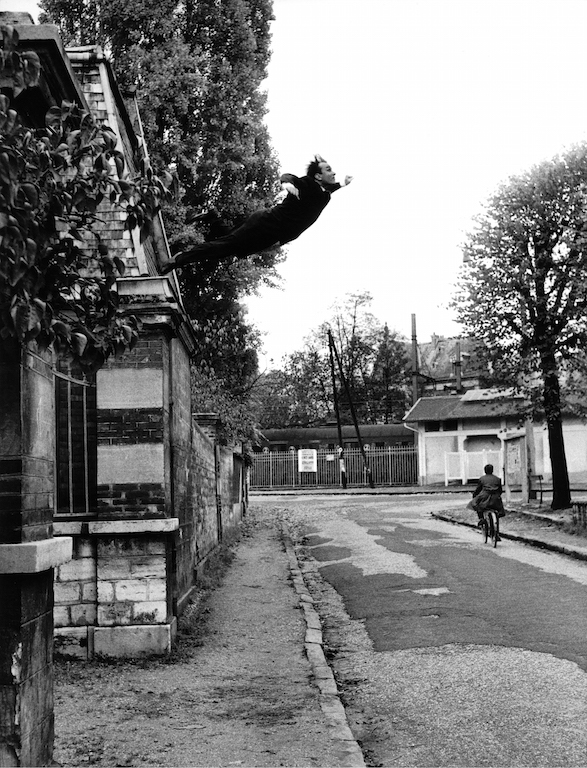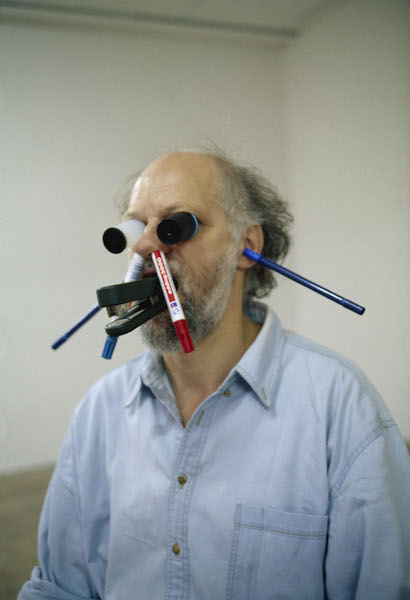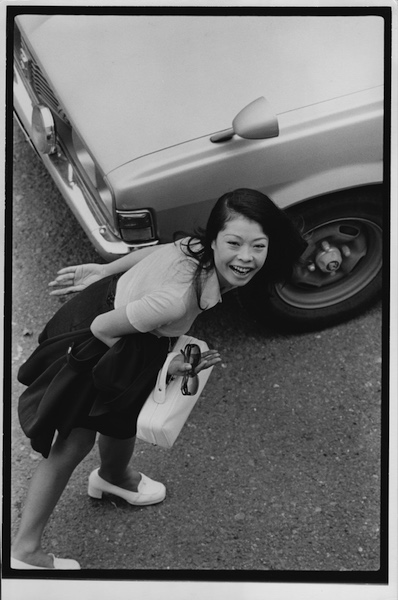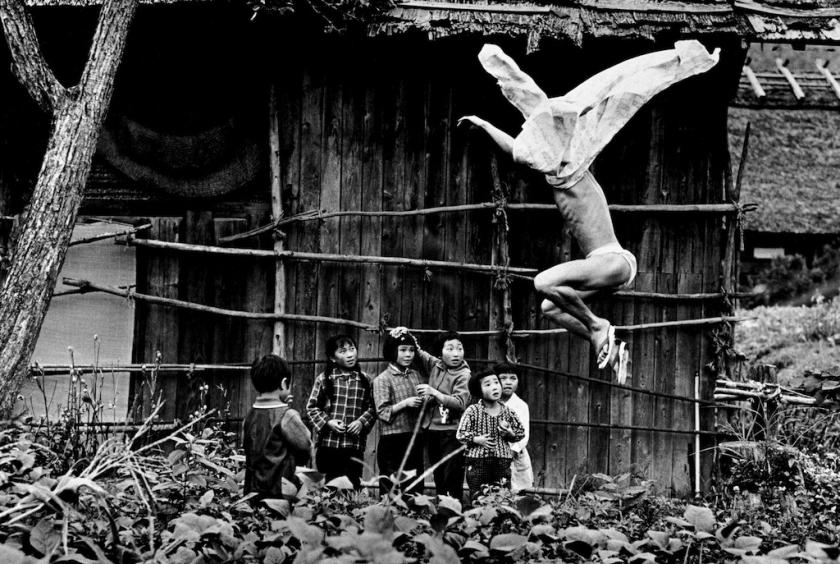The earliest known selfie is as old as the medium itself – literally. Hippolyte Bayard, one of the inventors of photography, pictured himself as a drowned man. His technique of photographic printing on paper had been upstaged by the daguerrotype, a metal plate alternative developed at the same time (1839) by Louis Daguerre. While Daguerre was showered with honours, Bayard was overlooked and, in disgust, he posed as a martyr to wasted endeavour; his hands stained with photographic chemicals, he slumps in a chair like a corpse newly dragged from the water.
Performing for the Camera explores every aspect of the multi-faceted relationship between performance and photography – from photographs which document performances that would otherwise be forgotten to events like Bayard’s “suicide”, staged specially for the camera, and all the ambiguities that lie between.
 Probably the best known and most iconic of all selfies is Yves Klein’s Leap into the Void of 1960 (pictured right). Having launched himself into the air from a high ledge, the artist hovers above the Paris pavement as though held aloft by the power of creative aspiration while, unaware of the miracle unfolding behind him, a cyclist rides by on the other side.
Probably the best known and most iconic of all selfies is Yves Klein’s Leap into the Void of 1960 (pictured right). Having launched himself into the air from a high ledge, the artist hovers above the Paris pavement as though held aloft by the power of creative aspiration while, unaware of the miracle unfolding behind him, a cyclist rides by on the other side.
And joy of all joys, we are shown how the event was masterminded. The elegant dive used in the final image was not easily achieved, it seems; various outtakes show the artist in an ungainly mid-air sprawl. Another shot reveals a group of men holding a tarpaulin to catch the artist as he crashes down. They were, of course, removed from the final montage.
Also on show is a sequence of shots of Klein’s famous Anthropometry, a performance staged in the same year for an invited audience attired in evening dress. An orchestra played a single note for 20 minutes, followed by 20 minutes of silence while, dressed in a tuxedo, Klein directed his “living paintbrushes”, a posse of naked women, who covered their bodies in ultramarine paint (International Klein Blue) and pressed themselves against blank canvases to produce a body imprint.
Whether genius or charlatan, Klein was one of the first artists to understand the power of showmanship and the importance of photographs for self-promotion. Andy Warhol, with his blank expression and trademark fright wig, Joseph Beuys, with his gaunt face and trilby hat, and Jeff Koons, with his sex appeal and boyish good looks, have similarly used their image to market themselves and create a brand. A whole room is devoted to their publicity shots, posters and adverts. In 1974 the American sculptor Lynda Benglis publicised her exhibition at the Paula Cooper Gallery with a tongue-in-cheek advert in Artforum. Her naked body adorned with a huge dildo, she challenges critics to take her as seriously as a man.
 Men and women have each used the camera to propose alternative versions of their identity. French surrealist Claude Cahun is represented here by a picture which gives little idea of the extraordinary range of personas she explored during the 1920s with the help of wigs, make-up, clothing and props – from Pierrot to monk, guru, angel, doll and aviator. Swiss artist Urs Lüthi, who similarly uses make-up and dress to explore gender fluidity, has been left out altogether along with British artist Jo Spence, whose photographs of her sick and aging self, taken after a diagnosis of breast cancer in 1982, broke many taboos about female beauty.
Men and women have each used the camera to propose alternative versions of their identity. French surrealist Claude Cahun is represented here by a picture which gives little idea of the extraordinary range of personas she explored during the 1920s with the help of wigs, make-up, clothing and props – from Pierrot to monk, guru, angel, doll and aviator. Swiss artist Urs Lüthi, who similarly uses make-up and dress to explore gender fluidity, has been left out altogether along with British artist Jo Spence, whose photographs of her sick and aging self, taken after a diagnosis of breast cancer in 1982, broke many taboos about female beauty.
American artist Joel-Peter Witkin, who uses disabled and obese models to offer disturbing visions of an alternative beauty, has also been excluded along with Arnulf Rainer, the Viennese Actionists and their messy and chaotic explorations of identity. The outcome may not be intentional, but the result is to normalise and sweeten this section of the show, especially since Robert Mapplethorpe is represented by a single photo of himself brandishing a knife – without the make-up, cross-dressing or S&M accoutrements of his other self-portraits. The lurking intensity of Francesca Woodman’s images of herself half-seen in shadow, crossed by sunlight or hidden behind a leaning door, provide the only glimpses of inner turmoil or neurosis; sadly she committed suicide in 1981 at the tender age of 22.
Film and video, which are as much a part of the story as photography, have also been left out – so no Rebecca Horn, Ulay and Abramović or Bruce Nauman, who are such an important part of the performance art picture. With a topic this unwieldy, though, you have to draw the line somewhere and, as a survey, this is pretty thorough. Yet I missed the iconic still of Yoko Ono’s seminal performance Cut Piece, which shows her sitting cross legged on the stage at Carnegie Hall in 1965, after audience members have snipped off most of her clothing with pinking sheers. Instead, Paul McCarthy represents the resurgence of performance art in New York – carving a groove with his nose through thick paint spread along the studio floor – and, using his body to slosh paint over walls and floor, Stuart Brisley exemplifies the British counterpart.
 I most enjoyed seeing images that are already familiar which, luckily for me, was most of them. Someone coming new to the topic, though, might find such a large array of black and white photographs a bit indigestible. Fortunately, some memorable pictures appear among the many that are mainly of documentary importance (pictured above left: Erwin Wurm's One Minute Sculptures, 1997). Working in 1969 with dancer Tatsumi Hijikata, the founder of Butoh, Japanese photographer Eikoh Hosoe enacted a series of scenes inspired by the legend of an evil spirit that haunts the countryside (main picture). Often using a fish eye lens, he created dramatic shots of Hijikata terrifying the locals by leaping and twirling through the air, or perching on rooftops and fence posts like a malevolent sprite.
I most enjoyed seeing images that are already familiar which, luckily for me, was most of them. Someone coming new to the topic, though, might find such a large array of black and white photographs a bit indigestible. Fortunately, some memorable pictures appear among the many that are mainly of documentary importance (pictured above left: Erwin Wurm's One Minute Sculptures, 1997). Working in 1969 with dancer Tatsumi Hijikata, the founder of Butoh, Japanese photographer Eikoh Hosoe enacted a series of scenes inspired by the legend of an evil spirit that haunts the countryside (main picture). Often using a fish eye lens, he created dramatic shots of Hijikata terrifying the locals by leaping and twirling through the air, or perching on rooftops and fence posts like a malevolent sprite.
The large triptych of Ai Weiwei deliberately dropping a priceless Han dynasty vase is as shocking as when it was taken 20 years ago. Between studio sittings, portrait photographer Samuel Fosso photographed himself in the guise of various world-famous black figures. Relying on clothing and props to recreate iconic pictures, he convincingly transforms himself into Haile Selassi, Angela Davis, Martin Luther King and others. At the other end of the spectrum are Masahisa Fukasi’s snapshots of his wife setting off for work each day (pictured above right). She grins up at him from the pavement below their apartment, sticking out her tongue, prancing about and generally making a mockery of the moment – just like a teenager taking selfies on the Tube.









![SEX MONEY RACE RELIGION [2016] by Gilbert and George. Installation shot of Gilbert & George 21ST CENTURY PICTURES Hayward Gallery](/sites/default/files/styles/thumbnail_125_x_125_/public/mastimages/Gilbert%20%26%20George_%2021ST%20CENTURY%20PICTURES.%20SEX%20MONEY%20RACE%20RELIGION%20%5B2016%5D.%20Photo_%20Mark%20Blower.%20Courtesy%20of%20the%20Gilbert%20%26%20George%20and%20the%20Hayward%20Gallery._0.jpg?itok=3oW-Y84i)





Add comment